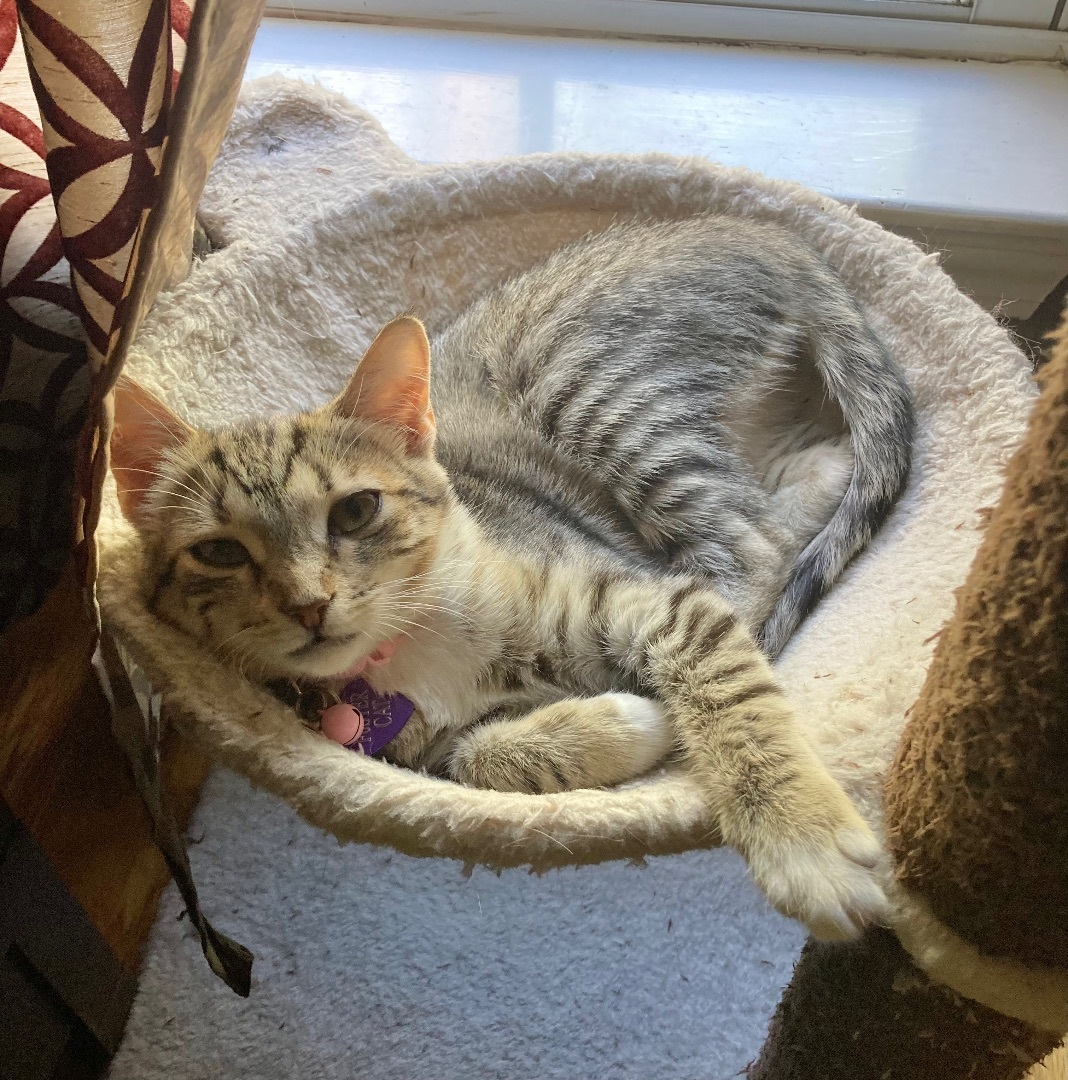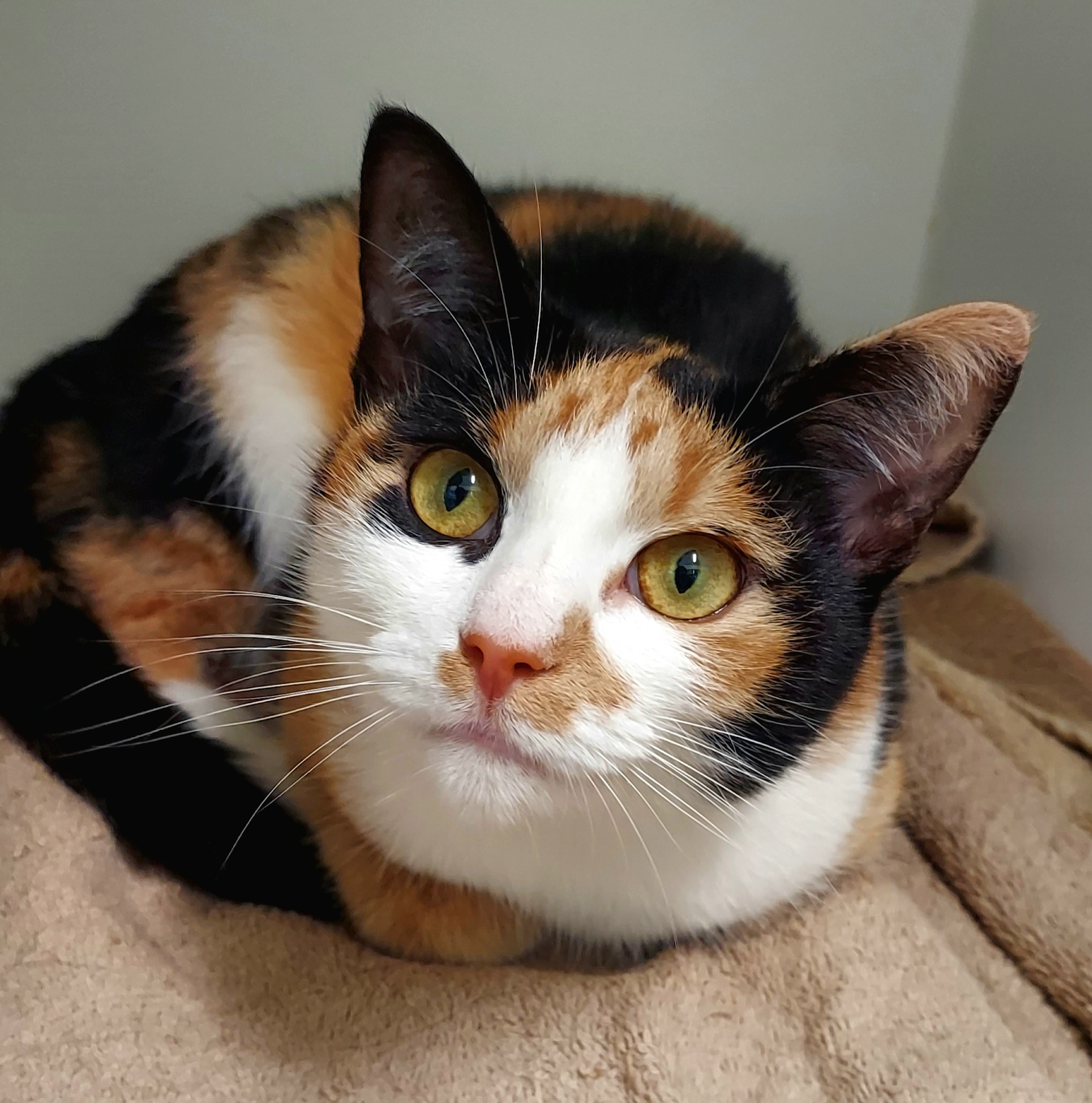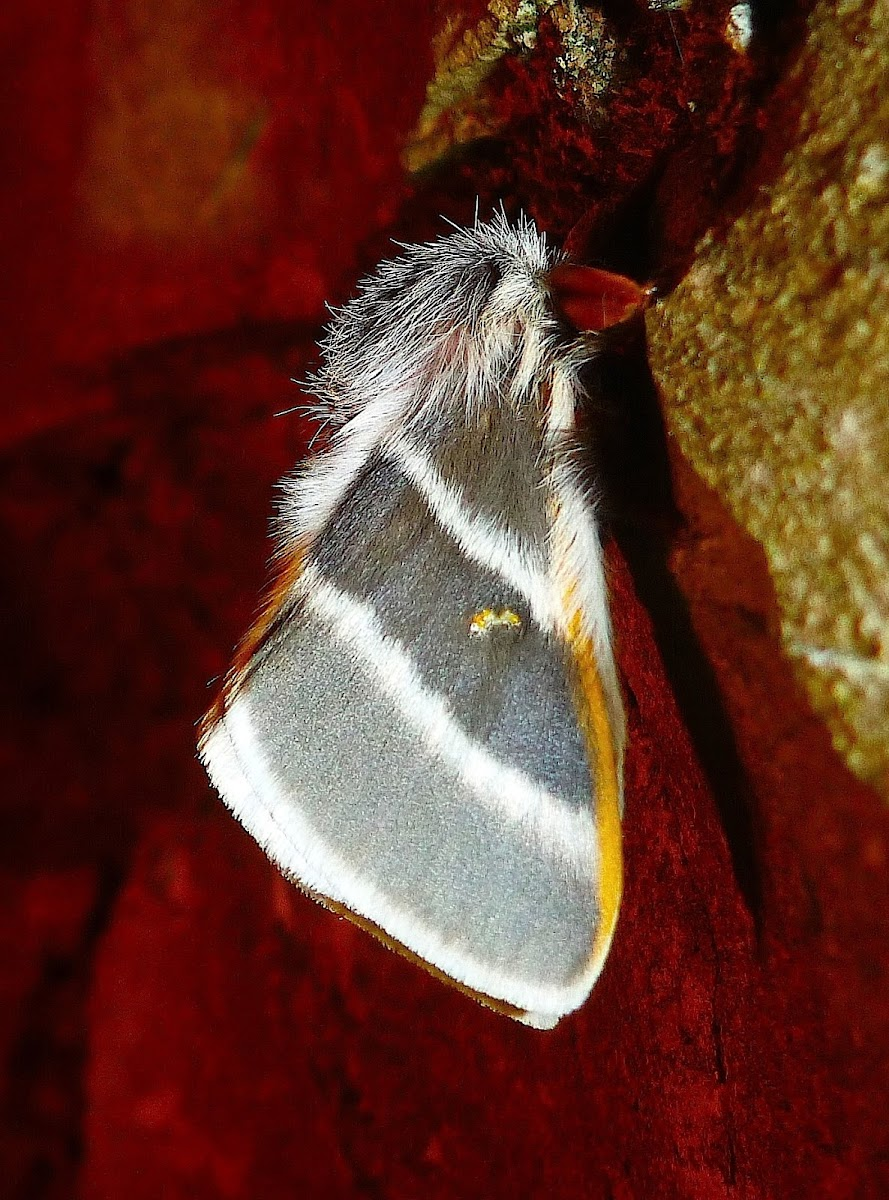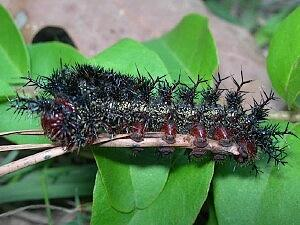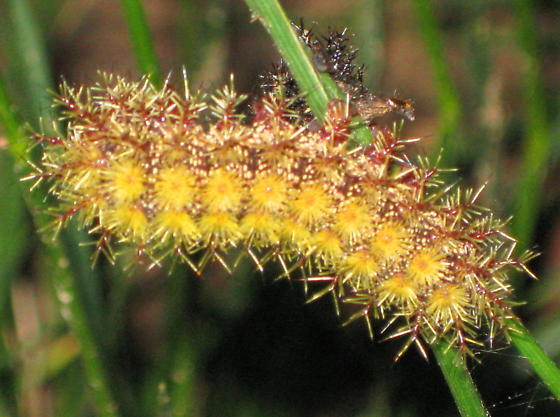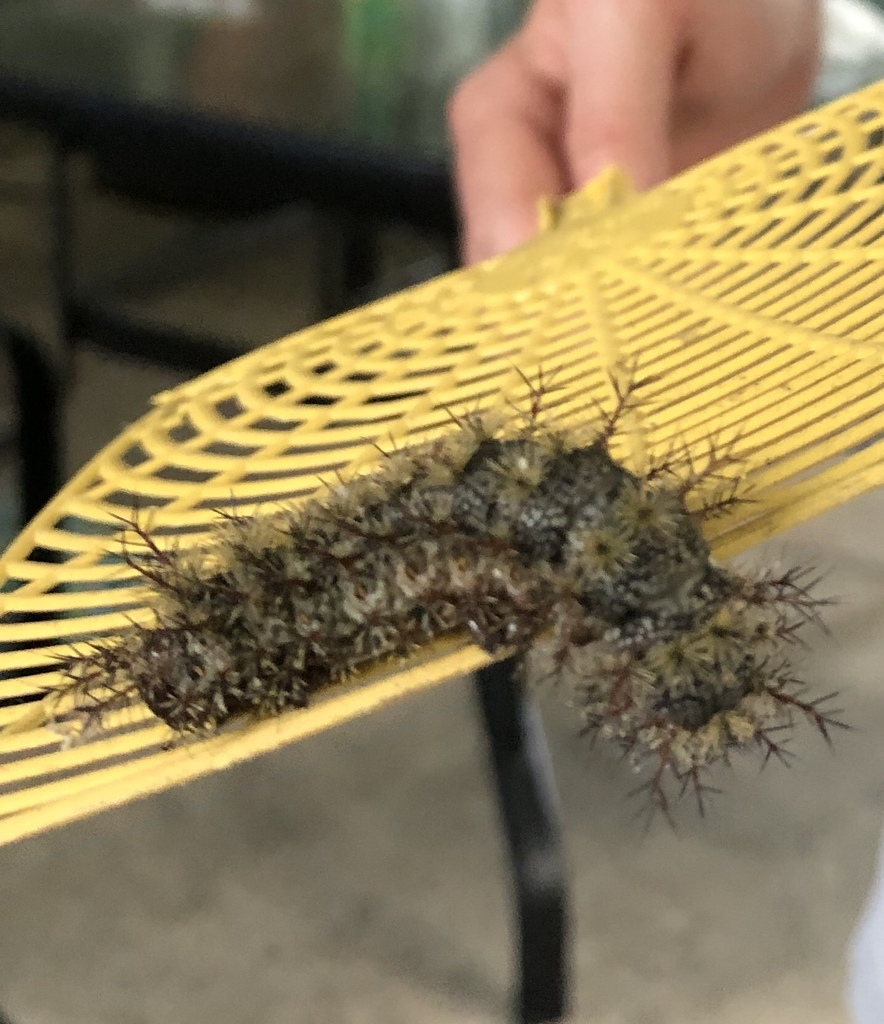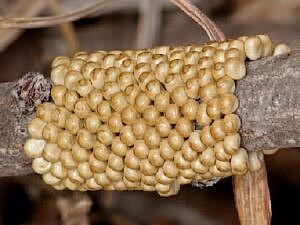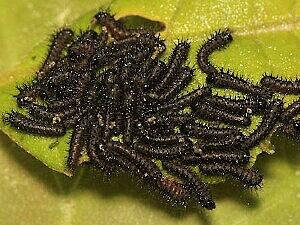Hemileuca maia, the Eastern Buck Moth, just might be the most hated of all the Hemileucas...because it's the best known. In the Eastern States, although some experts think we may have a half-dozen different species--if they are counted as species--of Hemileuca in the same woods at the same time, most people, including experts, simply call all our Hemileucas variant forms of maia. They are the species originally meant by the word "stingingworm" or "stinging caterpillar," though the other Hemileucas and some other silk moths qualify for those names too.
Photo from the University of Florida archives. Color shadings vary widely; some individuals can be described as black and white, some as soft grey or taupe, but a lighter band across the wings and spots that may suggest eyes are always present. Some individuals lose wing scales and have translucent wings. The wingspan is two to three inches, females usually a little larger than males. Males are more likely to have tufts of rusty-colored fur at the tail end. Young females have an egg-stuffed body shape; males and older females are slimmer. Males have plumier antennae. Both sexes have furry bodies and wing joints.
Photo by Alan Chin Lee. As caterpillars,
maia's primary defense is to curl up and drop to the ground with their bristles facing out, As moths, they no longer have bristles, and this behavior is probably counterproductive, but they have formed the habit. This appears to be a young male still expanding his wings, curling up instinctively as he stretches.
Photo by Shannon Schade. Stressed not only by stretching her wings but by being picked up by a human, this female regresses to the curled-up position too, while continuing to stretch her wings and exude her scent "call." The scent organ is visible posterior to--in this photo above--the grey fur on the tail end. Males can smell this damsel in distress a mile away and were probably bumbling through the air, rushing to her rescue, while Schade was snapping the picture.
This is, after all, the genus in which siblings separated after hatching and fed on different plants grow up looking different enough to belong to different species and, often, unable to produce viable mutual offspring. Hemileuca maia can eat different plants and have different looks. If it has access to the same food plants it can look remarkably similar to some of the Western species, or types, of Hemileuca.
Phoro by Lee Ruth. This is the type I encountered first. It is detested as the "raspberry caterpillar," with reddish and blue-grey mottled skin that can resemble raspberry canes, which are not its primary food plant but which it likes to infest just at raspberry harvest time. Up in the orchard I've checked for sections of brambles stripped of their leaves, found the guilty stingingworm usually still clinging to the plant, and dispatched it with a stick, many a time. They were
all purplish, with gray bristles and reddish feet. They were the reason why the siblings and I had to pick raspberries and deliver them to people who would otherwise have paid for the fun of picking their own.
Photo by Nancy Kent. This black-and-brown specimen is common in the Blue Ridge Mountains. Probably it ate cherry leaves as a mid-sized caterpillar.
Photo by Susan Ellis, showing how different the same type looks from a different angle.
Then again, at the same time of year, other stingingworms would be wandering about in the woods, likely to be found on any plant, bush, or tree that they had or hadn't been eating. Their color was nearly always black with brown-tipped bristles. On average they were shorter than the raspberry caterpillars, too. Raspberry-color-themed caterpillars stretched out closer to three inches; black-and-brown ones seldom measured more than two. Quite often they got into cherry trees and blueberry bushes. They looked like two different species. They were probably litter mates who ate different things as middle-sized caterpillars.+
Photo by Jgbecnel. Reports of North American caterpillars that were AT LEAST FOUR INCHES LONG!!! usually describe scenes like this. The caterpillar is molting--shedding its older, darker skin and emerging in a new, "teneral" skin whose color may change in the next few hours. It was photographed in Louisiana.
Then again, in the North Central States, a subspecies of maia that doesn't look particularly "different" is now often counted as a distinct species. Some authorities still overlook Hemileuca maia menyanthevora or list it as a subspecies of maia; an increasing number count H. menyanthevora as a separate species, as will this web site. The Florida subspecies H. maia warreni is also increasingly recognized as a distinct species.
In addition to menyanthevora, the species names orleans, sandra, and warreni are often considered as subspecies of maia. Peigleri, too, resembles maia and has been listed as a subspecies of maia. But species classification of Hemileucas is, as we have seen, a matter of flux and controversy. Maia and lucina look exactly alike to humans (despite tendencies for maia to be a little larger and lucina to have slightly more translucent wings), but they smell different to each other and are hard to persuade to crossbreed.
For those who were wondering, warreni lives in Florida--the peninsula, not the panhandle--and is able to fly in January. It is slightly smaller than maia and has more pointed wings, and the caterpillars' bristles form a distinctive pattern. Sandra, found mainly in New Jersey but sometimes considered to occur in a long swath south from there, is slightly larger than other maia and has darker, less translucent wings. Orleans lives on the Gulf Coast, is larger even than sandra, and has what some consider distinctly more brown coloring with opaque wings and cream-colored bands.
Some maia caterpillars are so conservatively dressed, in black and grey, they look as if they might be trying to fit into the crowd at some Ivy League law school.
Photo by Micah McDaniel. A surprising number of people snap "selfies" with the stingingworm that just stung them, often apparently because they picked it up. Duh! The first rule of not being stung by the little monsters is not to touch them. Their feet don't sting, but as they waddle over a human hand the bristles are likely to bump the skin.
Photo by Mudgiecrabshabistan, taken in Florida. Some have a color scheme based on gamboge, with orange-toned skin and lurid yellow bristles. (This color scheme may be peculiar to warreni; later in the year after this post's first appearance, this photo was added to Inaturalist's page for warreni.)
Photo by Jakemccumber. In this family, orange and black caterpillars show complete freedom from color prejudice.
Photo by Prestonjones31. This green color is uncommon but I've seen it in Virginia.
Photo by Joyce Bonner. Found in eastern Virginia, this is yet another variant form of
maia. I've never seen this form in real life.
Photo by J.R. Baker. From a distance it looks white; close up, it's still possible to see that the skin is black with
lots of white spots. This pale form was photographed in North Carolina and is another form of
maia I've never seen n real life.
Photo by Aaron Brees. This is another common type of
maia that I've never seen, but that many sources describe and photograph.
Photo by Brantport14. This one's plaid, with lengthwise and crosswise stripes mixing to form new shades of color. It may be sad--it's certainly blue--and it may be mad, possibly because it's too fat to walk very competently, and sometimes big fat caterpillars fall out of their trees. One minute they're stuffing their fat faces and the next minute they're falling into an unknown realm they've never been able to see. And, if they happen to be stingingworms, turning all their bristles out in order to land on them...quite possibly down the back of someone's neck.
Despite their mad variety all maias have one thing in common: They tolerate dampness better than the western Hemileucas. They can live and thrive and multiply east of the Mississippi River. They are vulnerable to fungus infections; more caterpillars survive in dry seasons than in wet ones. Still, local populations survive wet years. Their western look-alikes are unlikely to survive a wet year in the East.
The size and the bristles tell us the main thing we want to know about maia. That is that it needs killing. Not, of course, by poisoning the land with chemicals, which has made even feeble little nuisances like the codling moth and the corn earworm into major pests. In the Eastern States one is seldom very far from trees that supply good stout sticks. Take a good stout stick, take a long look at a Hemileuca caterpillar, and instinct will guide you to do the right thing.
Photo by Sbwear, showing an ineffective method of population control.
Hemileucas' bristles are solid enough that that floppy plastic flyswatter will bounce off. You want a sturdy stick, thicker than two fingers. If the caterpillar is crawling in soft dirt or leaf litter, use the stick to carry it onto a smooth flat surface where it won't just sink into the duff.
To know Hemileuca maia is, for rightminded people, to loathe it. Nevertheless, in Maine, some "wildlife" lovers wrote of threats to maia as if they would have objected to the species' going extinct:
I don't think there's much real hope, but local populations where I live have gone extinct before and are extinct now, and nobody misses them.
Many of the fun facts about maia below were collected by Professors Schowalter and Ring of Louisiana State University, who wrote a pamphlet about this species to help a community particularly plagued by it. I contributed to "Know Your Pest" leaflets on this species years before the LSU pamphlet was written; their document is much newer and contained some fresh new facts. It can be downloaded and printed as a PDF:
In addition to applying heavy enough pressure, from sticks or stones, to crush the caterpillars, another method of control is collecting the moths. Maia adults do better at avoiding humans than some of the Hemileucas do, but if you can find a scent-calling female and tie her on a thread or cage her in a small mesh box inside a big mesh box, you may be able to collect several males. A collection of maia pinned in rows in a box may interest a local school or museum. If not, they burn well.
Photo by Sdoss56. The moth behind the screen is a young female, wings no doubt modestly covering her pulsating scent gland. The three males are all hoping to be chosen to help her unload her burden of eggs. A person who still held a grudge against last summer's stingingworms (this is November in Alabama) could thin the local population by picking off those males and killing them.
More efficient means of control, of course, come from natural predators. Natural predators are usually abundant where their prey species are abundant--provided that nobody has tried to "control" the unwanted species by spraying poison, from which the nuisance species population always rebounds faster then the predator species do. The primary natural predators on Hemileucas are small--tachinid flies, which are just notably smaller and differently colored than house flies, and tiny wasps. These little animals are able to lay eggs in between the caterpillars' bristles. Despite their gregariousness Hemileucas are not built to groom each other's skins, so the microscopic larvae burrow right into the skin and devour the inside of the caterpillar.
Photo by Juliezickefoose. We don't know whether the bird or its young will eat the caterpillar, nor whether they'll be sorry, but we know the bird killed it.
Wasps and stinkbugs are occasionally able to kill and eat the caterpillars, and birds and mice sometimes eat the moths, but what seem to get Hemileuca numbers down are the little tachinid flies, braconid wasps, and perhaps a few other species that parasitize large caterpillars. A study on Cape Cod found significantly lowered maia populations around power lines with correspondingly higher rates of parasitism by an introduced tachinid species.
Photo by Theo_Witsell. This caterpillar has been parasitized. It's still crawling through one day at a time. It can still sting, but it won't become a moth.
Young caterpillars are very vulnerable to an infection called nuclear polyhedrosis virus or NPV. Older caterpillars have more resistance to this virus.
Then of course there's the fungus infection deliberately introduced in some parts of the Eastern States to slow the spread of the invasive nuisance Lymantria dispar. ("Spongies," from the look of the egg clusters, is now preferred to "gypsy moths" or "gyps.") Hemileucas are very vulnerable to fungus infections. While other native species have been decimated and been sorely missed--Monarch butterflies, Luna moths, and other popular favorites are vulnerable too--it has been pleasant, for summer after summer now, not to see a single Hemileuca.
How do we keep Hemileuca populations low? With maia the secret seems to be limiting the proportion of oak to other trees. As climax forests grow up in oak, or when suburb dwellers plant an oak tree on every lawn up and down the street, Hemileuca populations increase. Other trees found in climax forests in the Eastern States attract their own pest species, but few of these are as obnoxious as stingingworms. Most varieties of maia lay their eggs on the uppermost twigs of oak trees, where the caterpillars live in clumps and eat their way through their first three caterpillar skins; then they disperse, and what they eat seems to determine the size and color they achieve before pupating.
What if you want your local population not to go extinct? First of all I recommend being very quiet about this. Humans don't like stingingworms so, if you do, questions about your real species identity will arise. However, humans may respond more favorably to an effort to conserve a clump of bog beans or an oak tree deep in the woods where nobody has ever WANTED to live, work, farm, etc. Like the mosquitoes that benefitted from efforts to stop draining all the swamps and conserve some natural wetlands, a few Hemileucas may be tolerated so long as they don't spread out from their habitat or make themselves conspicuous when humans visit it.
Pesticide spraying and forest fires are two factors that have very mixed effects on insect populations. Some plants, including the oak trees maia eats, refoliate more aggressively if they have managed to survive a fire, and maia grow faster and stronger on this new growth. Nuisance species other than the target species are often killed by direct exposure to pesticides, but as nuisance species usually became nuisances by being hardier and reproducing faster than their predators, they rebound and become more serious nuisances after spraying...Hemileuca maia populations really exploded, all across the Eastern States, during the years when "safe and effective Roundup" (glyphosate) was being sold for all farm, lawn, garden, and road verge "weed" control. This trend eventually flattened out and, in some of the Eastern States, germ warfare against Lymantria dispar has devastated Hemileuca maia populations.
In places where people feel deeply attached to their old oak trees, as with the live oaks in New Orleans, people just have to accept a trade-off. All those picturesque live oaks fill up with Hemileuca maia in the spring, and so long as people want to cherish those trees, they are advised to carry umbrellas when walking under trees that are likely to rain stingingworms.
Its typical color pattern is one of the subtle, not quite "half white," gray-based schemes for which the genus is named, and it was recognized early enough to be named after a goddess known to have been actually worshipped--Maia, the spirit of springtime, from whom we get the name "May."
The moths were named "buck moths" by deer hunters who encountered them in buck hunting season. They belong to the silk moth family but, unlike the bigger silk moths who rest with their wings spread out parallel to the surface, the Hemileucas fold up their wings as the Noctuids do, reducing their size and presumably their appeal to hungry birds and mice. They have gray or brown and white wings and often have black, white, or brightly colored fur on the body. For silk moths they produce remarkably little silk; most Hemileucas, like maia, don't even spin cocoons.
Maia is most easily distinguished from lucina, artemis, nevadensis, menyanthevora, and several other species by its instinctive behavior as a young caterpillar. Hatchlings normally prefer the kind of leaves on which they will grow best, and though these types may survive on one another's food, maia are most likely to thrive and grow up when they can eat oak leaves. Black cherry, willow, birch, and poplar leaves are sometimes also eaten. Raspberry, blackberry, and blueberry are not primary food sources, but stingingworms often nibble on them while wandering about looking for a place to pupate. At this age they are large and voracious enough that a nibble may strip leaves from a foot or two of berry bush or cherry tree during the days when humans are picking berries and cherries. However, in some studies, about 95% of caterpillars who ate oak leaves lived to pupate, and about 5% of maia caterpillars who ate other kinds of leaves did.
Adult moths don't eat; they have no mouths or digestive organs. They live on fat stored as caterpillars, and don't have much of that. (Egg-stuffed females can look fat; males, and females who have laid most or all of their eggs, look skinny.) Fat is stored mostly in the thorax and lasts them a week, if that.
After pupating for a few months in loose dirt or leaf litter, the adult moths eclose usually in October, sometimes November in the South. Some believe that a few each year remain in pupation through one winter and emerge as adult moths next fall.
Photo by Mgochfeld. This newly eclosed female will be much prettier in a few hours, when her wings have expanded. Newly eclosed males look thinner but not more attractive.
They don't have much time to waste on unnecessary flight, and fly by day, resting at night and not fluttering around lights. Males fly further and faster, tracking females by scent. They're known for flying "erratically" as they try to follow scent trails through gusty winds. Females look for adequate space for their babies to hatch and grow, but living in the tops of big trees means they don't have to fly very far. When several oak trees grow close together the female can spend most of her time, in between unloading each brood, resting and hiding from predators, and more eggs are successfully laid. When oak trees are widely separated females lead a riskier life and presumably produce fewer eggs.
They identify one another by scent. Humans don't smell their scent, but laboratory tests have identified three chemical compounds that must be combined in a precise proportion to attract male maia. Synthetic scents can be used to trap male moths and prevent them reproducing, just as the natural scent of a trapped female moth can do.
Photo by Aaron Brees. Although they don't form pair bonds or seem to recognize each other after mating,
Hemileucas often mate face to face and spend time, before and after the act of egg fertilization, cuddling and enjoying each other's company. Sometimes one moth even enfolds the other between its wings. (Most moths try to keep their wings separated while mating.)
Photo by Crx2aj3. The rusty tail tuft is more common on males; here's proof that it can appear on females, too. This young, egg-loaded female is just starting to lay her eggs.
Photo by Tom Murray. It's estimated that each female moth lays about 150 eggs, typically about half in the first brood and two or three smaller broods later.
Like other Hemileucas, the female moth lays a batch of eggs in rings or spirals, their sides touching, around a twig. Caterpillars hatch about the time new oak leaves start growing--March in the South, May or June in the North.
Photo by Tom Murray. Not all of them will live even long enough to grow out of their first caterpillar skins, but
maia does produce large litters. Hatchlings seem to feel safest when touching a sibling. Their bristles maintain the amount of air space between them that they need; they don't sting each other.
Photo by Maurabarry. Is a procession forming? When they have to travel any distance
maias may march in a procession, like European processionary caterpillars, one caterpillar's head touching another's tail; one caterpillar becomes the leader, and losing that caterpillar throws the others into confusion for a while, until they pick a new leader and resume their procession. Even after reaching sizes and appetites that motivate them to spread out so that each one can strip a different branch of the host tree, when it's time to leave the host tree some
maias will line up and move into the unknown in the security of a single-file line. They don't know where they're going and the line may form a curve, but they seem to have regressed emotionally and be seeking the old comfort of blindly following a sibling. (This is not behavior I've seen; it's documented in places where dense oak forests allow this species to form dense populations.)
Photo by Ahalbroo. Processionary caterpillars are notoriously dumb animals, sometimes used as a sort of definition of mindless behavior. These
maias don't seem much brighter than their European counterparts...but maybe parading in a circle serves some purpose for them other than getting anywhere in particular.
Photo by Grahamgerdeman. These little stingingworms are going somewhere. Not that they necessarily know where.
Hatchlings have long straight spines, which are hollow and brittle and route venom up from venom glands under the skin. Older caterpillars develop long branching spines. (I once counted the spines on a raspberry caterpillar I was drowning in alcohol. It had sixty-three. Each of those sixty-three spines does about as much damage as a bee sting, though fortunately people seldom touch all of them.) Some maias eventually develop flattened rosettes of bristles. The more bristles touch your skin, the more painful the sting will be; rosette-bristled species like Automeris io were reported by a volunteer to cause more pain than branching bristles of which only one tip would normally puncture the skin.
Being stung by a stingingworm has been described as anywhere from "mild irritation, like touching nettles" to "pain causing nausea or fainting." The area stung and the individual's reaction to insect venom determine how unpleasant the experience is. Even non-venomous hairy caterpillars or, for that matter, short cut ends of your own hair, will raise a brief yet miserable rash if they get down your neck on a hot day. Extremely sensitive people could go into anaphylactic shock in reaction to maia stings, but this rarely happens. A study of "caterpillar envenomation" in Louisiana in 1987 found that 112 people sought medical help for reactions to caterpillar stings. When the caterpillars were identified, 49% were Hemileuca maia, 22% were Megalopyge opercularis, 16% Sibine (or Acharia) stimulea, and 11% Automeris io. None of the patients went into anaphylactic shock. They were successfully treated by patting the skin with duct tape to remove any bristle ends from the skin and applying ice.
As with all insect stings, it's important to remove any part of the sting from the wound. A volunteer called Diaz intentionally left maia bristle tips stuck in his skin for ten days. He reported that these tiny bits of bristles continued to irritate his skin, causing pinpoint "hemorrhaging," until after ten days he gave up and removed them.
Weather conditions that favor high rates of survival in Hemileuca maia also seem to favor high population levels for two non-venomous (though hairy and prickly) caterpillars, Orgyia leucostigma and Malacosoma disstria. Both of these species normally live in treetops and do no harm to humans, but can become nuisances when population levels are high. They, and also H. maia, occasionally defoliate much or all of a large tree. Trees are prepared to survive one defoliation in spring, whether due to frost or to animals eating leaves. Only if one tree is defoliated twice in the same year is the tree in any danger. Fruit trees that looked bare in May may refoliate and produce fruit in June.
In two or three months, again depending on environmental factors, the caterpillars are ready to pupate. In New Orleans, where many of these caterpillar have spent their whole lives near the top of a live oak tree, they may walk down the tree for the first time in a ragtag procession. In many places the caterpillars disperse long before they pupate. In any case they hide under an inch or two of loose soil and/or leaf litter; the final caterpillar skin sloughs off and the pupa lies still and tries to look dead for a few months. In the South pupation may begin in May; in the North caterpillars may still be crawling and eating in August.
Photo by Lacy L. Hyche.
Hemileuca pupae can be recognized by being found close to the bristly cast-off caterpillar skin, which usually decays slowly because the bristles still contain venom.
Usually in October, sometimes September, sometimes November, most of the spring caterpillars will complete pupation and emerge as moths. They crawl up from their shallow burrows as soon as their legs are functional, while their wings are still crumpled stubs, and spend a few hours hoping nobody else sees them until they look like moths. They can't fly until their wings are fully expanded and solidified, which makes them vulnerable, like the young ones caught by humans at the top of this page. They are now defenseless, and can safely be petted if humans want to torture them. (But beware; touching or being touched by a moth leaves traces of its scent on you, and other moths will follow or even search you, trying to find what smells to them as if it might have been their beshert.)
Then the wings reach their full size and the moths' blood starts pumping through their tail ends, the females' scent glands start "calling," and the cycle starts again.



